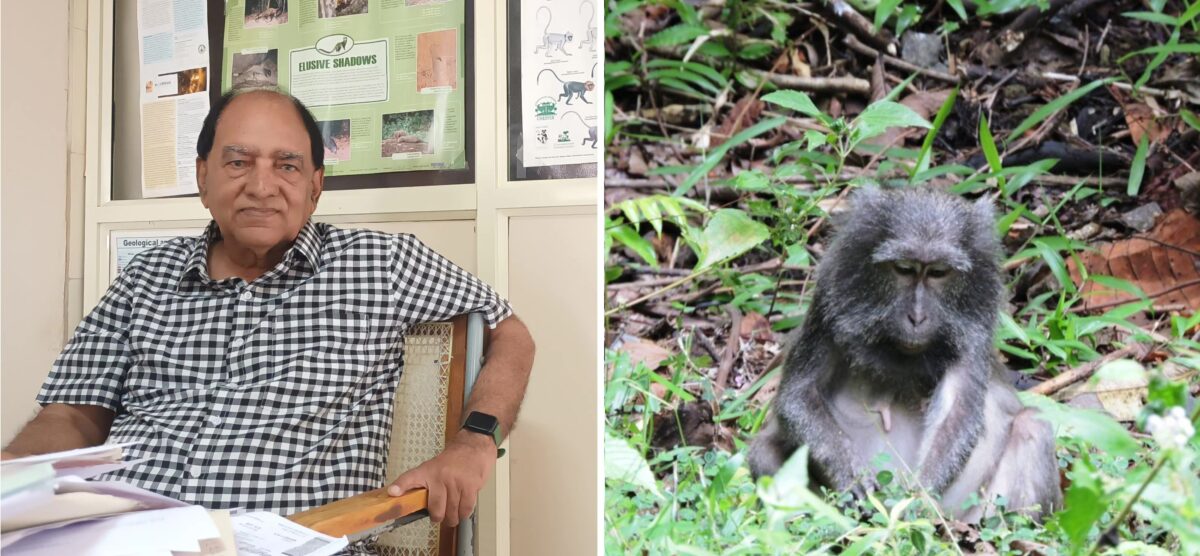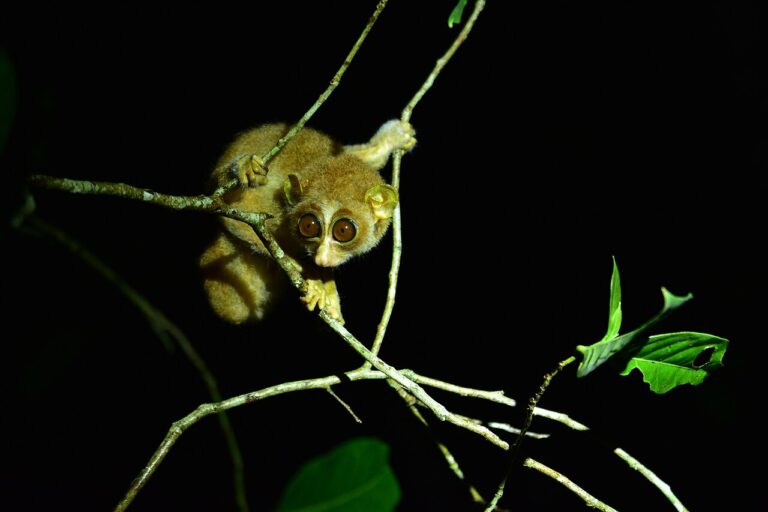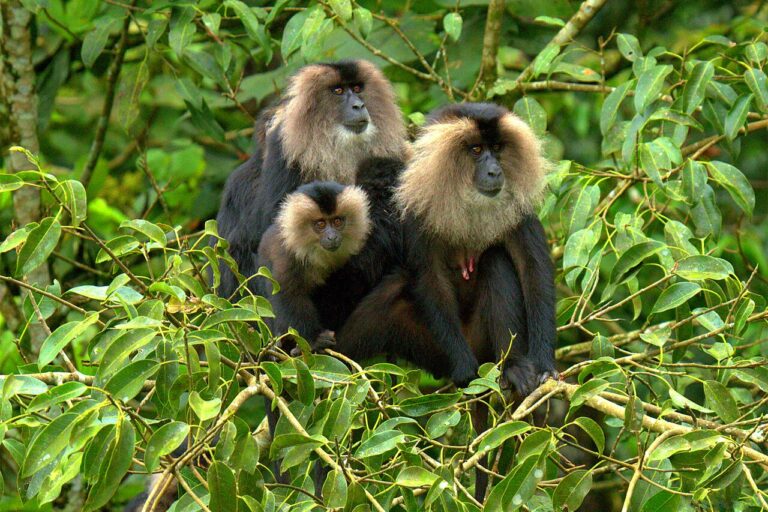
- In this interview with Mongabay India, ecology and animal behaviour expert Mewa Singh shares his observations about primate behaviours, skill development and adaptability.
- Unlike many species with hardwired behaviours, primates exhibit remarkable behavioural diversity shaped by prolonged socialisation and learning, allowing adaptation across habitats.
- Urban adaptability of monkeys fosters complex skills that could escalate conflict, resulting in management interventions, including trapping, relocation, and killing, says Singh.
The field of primatology is no monkey business. Primates are complex, social animals with highly adaptable behaviour that changes with habitats. Mewa Singh, a life-long distinguished professor of ecology and animal behaviour at the University of Mysore’s Biopsychology Department has been studying primate behaviour in their natural settings for over half a century, spanning diverse regions including the Himalayas, the Western Ghats, the Eastern Ghats, and the Nicobar Islands. Having authored over 200 research articles and co-authored the book Macaque Societies: A Model for the Study of Social Organisation, his research has a strong focus on species such as the lion-tailed macaque, Nicobar long-tailed macaque, bonnet macaque, langur and slender loris.
Singh’s remarkable trajectory — from studying psychology to becoming a globally renowned wildlife biologist — is a testimony in interdisciplinary passion and scholarly dedication.
Mongabay: You’re a wildlife biologist and an ethologist. What’s ethology and its relevance in species studies?
Mewa Singh (MS): Ethology is the scientific study of animal behaviour in their natural settings. While most research in animal behaviour has happened in laboratories, ethologists work in the field, observing animals where they live. The discipline began with research on insects, and many ethology conferences are still dominated by studies on insects and birds. Mammals are less represented, though my work focuses mainly on them.

One of my focus areas is how urban monkeys encounter food resources. It is very different from their forest-dwelling counterparts, requiring extraction and processing skills. This exposure leads to the development of new behavioural skills. The same species in forests often lack these behaviours and skills.
Ethology asks four central questions. One is, function: What purpose does the behaviour serve? How does it help the animal survive or reproduce? Secondly, the cause: What triggers the behaviour? The causes can be hormonal, neural, or environmental stimuli. Thirdly, the development: Is the behaviour present at birth (innate) or learned over time? For example, fish can swim without being taught, while many bird behaviours are learned. And lastly, the evolutionary origin or phylogeny: How did the behaviour evolve over time, and what can be learnt from related species?
The answers to these questions help ethologists understand biological rhythms, seasonal patterns, reproductive cycles, and learned skills.
Mongabay: What are some of the primate behaviours and skills developed as a result of changes in the environment?
MS: Across the world, if you look at primate behaviour, there are striking changes that are not necessarily related to food. What makes these changes interesting is that they tell us about our evolutionary origins: How we became what we are. Studying primates helps trace our evolutionary history because they are our closest genetic relatives.
Of course, studying animal behaviour isn’t only about understanding humans. It’s valuable in its own right because it reveals so much about evolution and the general principles that shape behaviour.
Primates are particularly fascinating in this regard because they are both genetically close to us and ecologically diverse, and their behaviour is equally varied. For instance, if you compare the same species of monkey in two different places — say Bandipur and Mysore (Mysuru) — you may find such stark behavioural differences that, without knowing they are the same species, you might assume they are entirely different animals. This level of variation is rare.
Insects like ants or bees also display complex behaviours, but these behaviours remain largely the same no matter where you observe them. In contrast, primates’ behaviour can change dramatically depending on the habitat, much like human cultures vary across regions.

Mongabay: Why are primate behaviours so diverse?
MS: Behavioural diversity in primates is linked to the flexibility of learning. In many animal species, especially those with highly adaptable adults, behaviour can vary greatly because different habitats demand different adaptations. These species don’t rely on genetic changes alone, they depend on prolonged socialisation. Young primates learn from their parents and peers over an extended period, and this learning shapes their adult behaviour. For bonnet macaques, for instance, this process lasts about two to three years in a lifespan of 19-20 years.
By contrast, in some species like certain birds, chicks hatch and can fly within hours — meaning much of their behaviour is hardwired and remains static across populations. In organisms such as primates however, behaviour is far more flexible, and this flexibility is what allows them to adapt successfully to a wide range of environments.
Mongabay: How do food choices and foraging behaviour among primates change with habitats? What are the outcomes of it?
MS: Environmental conditions and food availability strongly influence growth, reproduction, and behaviour. Lion-tailed macaques begin reproducing at five to six years, but in captivity with better nutrition, this can be as early as three-and-a-half to four years.
Urban monkeys often have access to processed, high-calorie human foods, leading to obesity, skin problems, and higher parasite loads compared to forest monkeys. Their gut biome changes with these foods. A study in Tamil Nadu showed that parasites from released urban monkeys spread to wild forest monkeys.

Female macaques often weigh less than their male counterparts. When we measured monkeys during one of the studies, we found a striking difference in their weights. For instance: female bonnet macaques on Chamundi Hills in Mysuru (urban area) weighed as much as the wild males in the forest. This is clear evidence of urban overnutrition and reduced activity. In forests, macaques may spend 60-65% of their day foraging, sometimes climbing hundreds of metres in search of seasonal foods, keeping them lean and fit.
Urban monkeys develop complex skills, especially in foraging and interacting with humans. They learn to open bottles, break coconuts, raid shops, and even time their actions to human inattentiveness. In North India’s Jakhu Temple, rhesus macaques have been observed taking eyeglasses and only returning them when given food. It’s a learned behaviour that likely developed gradually over decades.
Even in forests, diet shapes behaviour. Leaf-eating langurs, such as the Nilgiri langurs spend a long time sleeping as the leaves take longer to digest in their stomachs. In contrast, Hanuman langurs (Semnopithecus) that eat fruits are more social since easy and quicker digestion facilitates more time for socialising.
Mongabay: Is adaptability necessarily a positive trait?
MS: Behaviour can drive evolutionary change. For example, human tool-use likely altered hand structure over thousands of generations, leading to our precision grip. Genetic traits can remain dormant until triggered by environmental cues — a concept known as environmental release. Ducks, for example, imprint on the first moving object they see after hatching; in experiments, this could be a human researcher.
Urbanisation over the last 10-15 years has changed habitats drastically. In cities like Mysuru, many bird species have disappeared with tree loss, leaving mainly pigeons and crows. For monkeys, new behaviours and skills in urban settings are mostly discouraging; such skills can increase human–monkey conflict. People tolerate simple food theft, but sophisticated behaviours, such as raiding shops and stealing valuables, lead to more aggressive management, including trapping, relocation, and even killing. I’ve seen hundreds of cases of monkeys poisoned or shot. While their skill development is scientifically fascinating, it increases the likelihood of harm to both humans and monkeys.
Read more: Rohini Balakrishnan on why (and how) we must listen to insects [Interview]
Banner image: A Hanuman langur also known as the grey langur (Semnopithecus) leaps over tree tops in Nagarahole Tiger Reserve, Karnataka. Image by Nikhil More via Wikimedia Commons (CC BY-SA 4.0).



























































































































































































































































































































































































































































































































































